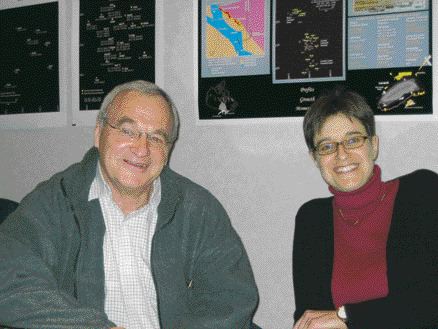Gord Morrison and Catharine Farrow have always tried to fly “under the radar.”
Blending in was easy for the geologists when they worked at nickel giant
The two have been key to the company’s swift and dramatic rise since 2001, when president and CEO Terry MacGibbon — another Inco alumnus — secured exploration rights for five past-producing Inco properties in the Sudbury basin. Morrison, a 32-year veteran with Inco, was “on loan” from the company in 2002 when he put together the exploration team for the fast-moving junior, which spent $30 million over two years on exploration — a breakneck speed. Farrow, who spent six years with Inco, joined FNX in 2003, helping to devise new ways of deciphering the basin, leading to the identification of the new high-grade nickel-copper-PGE deposit at the Levack mine last year, among others.
The company’s speedy growth has astonished everyone — Morrison and Farrow included. Commercial production was achieved at the McCreedy West mine in November 2003, with the Levack mine expected to follow this year, and the company’s shares are now trading around $15.50 in a 52-week range of $4.65 to $16.30.
“In four years, (FNX has) gone from one employee (MacGibbon) and a guy that was on loan from Inco to a $1.3-billion market cap,” Farrow said recently at FNX’s downtown Toronto office. “It’s just overwhelming.”
“Everybody wants to create another FNX,” mused Morrison, seated next to Farrow. But the “FNX model,” which involved a partnership with a major, the use of a contractor (
“I don’t think it’s possible for somebody out there to go and be as successful as FNX has been because there were too many variables that need to be duplicated, that can’t,” Morrison explained.
Some factors Morrison and Farrow attribute to the success of FNX are MacGibbon’s vision and ability to raise money, timing — particularly the availability of five “brilliant” properties — and the talent the company recruited from Australia’s WMC Resources, which at the time was downsizing its North American operations.
Morrison and Farrow did their part, too. Morrison contributed the practical and proven exploration expertise that Farrow said has made him “one of the most successful explorers in the last 30 years in Sudbury,” and, for her part, Farrow contributed her intellect and book smarts as “the geeky academic.” Both say that their different backgrounds and approaches complement each other, and admit they’ve had their greatest impact as a team.
“We think very much the same in terms of overall strategy and the overall goal . . . in terms of exploration,” Morrison said. “But in terms of getting there — it’s a different story.”
The two met while doing separate work in the Sudbury basin in 1992 (Farrow was working on her PhD) and started working together when she joined Inco in 1996. As a long-time employee there, Morrison was asked to be a mentor of sorts to Farrow.
“I quickly found out, after the first six months, that I had as much to learn from Catharine as my teaching her,” he recalled.
Having Catharine join the FNX team in February 2003 was a “real shot in the arm,” he said.
FNX was “motoring” at the time, said Morrison, who had just made the official full-time leap to the junior in January 2003, after spending the previous year splitting time between the two companies. It was only when he got a call from Farrow, who was looking to branch out, that he realized he could use a hand.
“I wanted to learn more about the business . . . of the exploration and mining industry — not just the academic side — and see if I could make a difference,” Farrow said. “I thought I could, but it wasn’t my background, so Terry and Gord took a chance.”
Despite the optics, there was no breach of the no-poaching agreement between Inco and FNX.
“It was my decision — I hadn’t even talked to Gord at the time,” said Farrow, adding that Inco’s management was supportive.
One of the things FNX has been able to do differently in the basin is bring a new approach to an area that had been well-explored for a century.
“There are some very traditional models that are used to explore at Sudbury, and those traditional models have been successful to a point,” Morrision said. “We realized that to go to the next step, we needed to do something different.”
That new approach built on the reams of historical data that were available for the Sudbury properties. Two-million feet of corehole had been drilled at Levack alone, Morrison said.
“We are designed to handle — like a big company — big datasets,” Farrow explained. “I think that one of the keys (to FNX’s success) has been we can manage those large datasets, integrate new geological concepts, apply high-end technology, and honour the legacy datasets. That’s the key, because you can apply new techniques, but if you have no way of linking them to the legacy datasets, it doesn’t really mean much.”
Given the success they’ve had with FNX, Morrison isn’t surprised if others perceive the duo as living out every geologist’s dream; FNX has given them the “freedom to let loose,” as well as a chance to prove themselves.
“When you’re working for a large company, even though you have success, you always wonder whether you could do it on your own,” Morrison said.
With FNX, Morrison and Farrow are finding that out — and neither knows what challenges lie ahead.
“You can’t predict the ride — it’s like riding a bull,” Morrison said. “There are very few people who want to get on the bull. But when you make the decision to get on the bull, you have to stick with it.”


Be the first to comment on "FNX a wild ride for ex-Inco geologists"